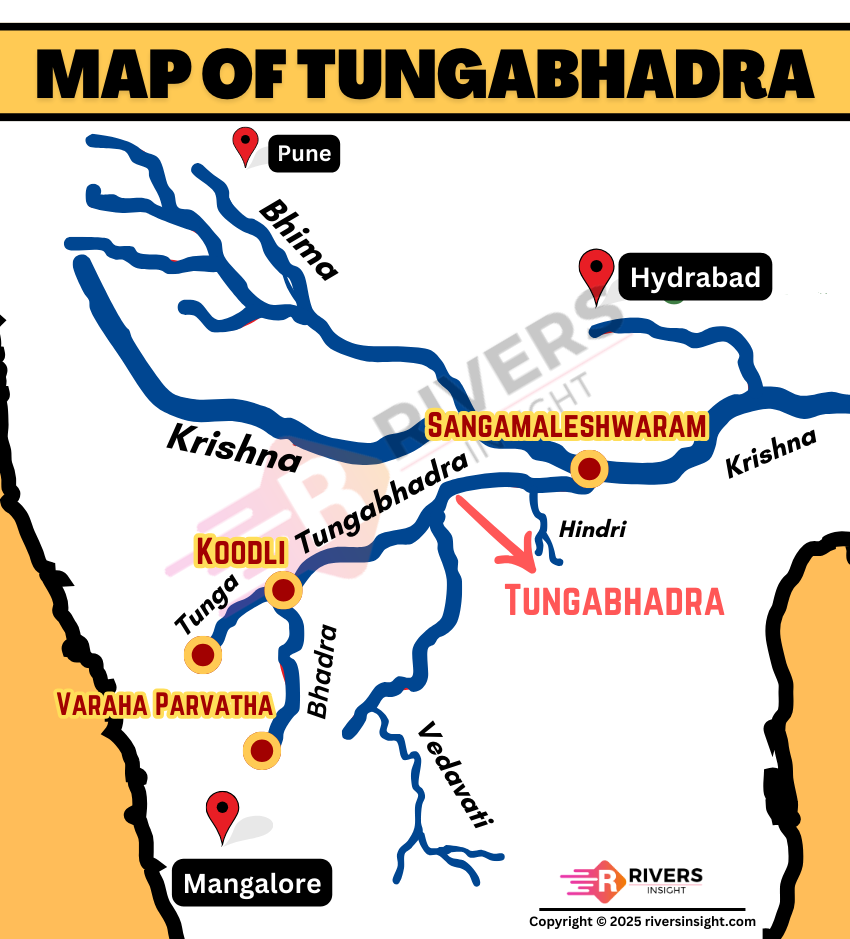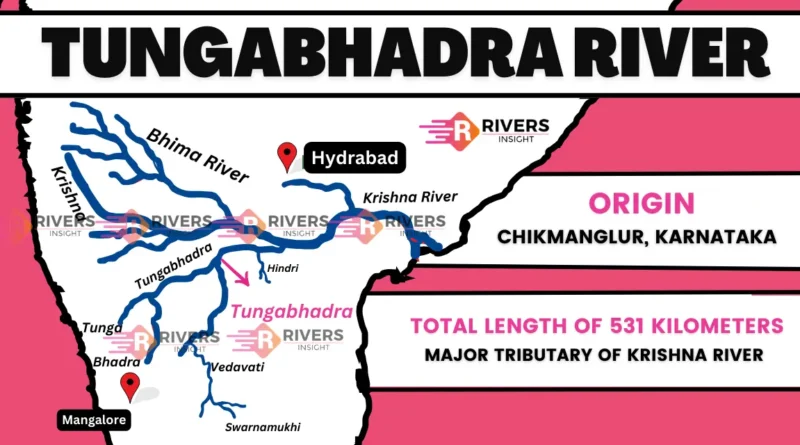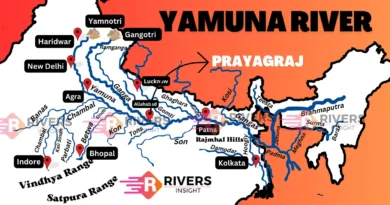Tungabhadra River: Map, Origin, States, Tributaries & Dams
Tungabhadra River is an important river in southern India, flowing through Karnataka and Andhra Pradesh. It originates at Koodli, where the Tunga and Bhadra Rivers meet, forming the Tungabhadra. The river flows for approximately 531 km before joining the Krishna River at Sangamaleshwaram. The river is not only geographically significant but also historically and culturally important due to its connection with the Vijayanagar Empire and sites like Hampi.
| Location | Southern India |
| Origin | Koodli, Karnataka (Tunga + Bhadra Confluence) |
| Tunga River Origin | Gangamoola Hills, Chikkamagaluru |
| Bhadra River Origin | Bhadra Wildlife Sanctuary, Karanataka |
| Length | 531 km |
| Flows Through | Karnataka and Andhra Pradesh |
| End Point | Sangamaleshwaram |
| Important Sites | Hampi |
Table of Contents
Origin of the Tungabhadra River
Tungabhadra River begins at Koodli in Karnataka, where the Tunga and Bhadra Rivers meet.
- Tunga River originates from the Gangamoola Hills (Varaha Parvatha) in Chikkamagaluru.
- Bhadra River originates from the Bhadra Wildlife Sanctuary, near Samse village in Chikkamagaluru.
These rivers flow independently for a short distance before converging at Koodli, forming the Tungabhadra.
Course
- The river flows southeast through Karnataka and Andhra Pradesh.
- Key cities along the course:
- Shimoga (near the origin point)
- Hospet
- Hampi (a UNESCO World Heritage Site)
- Koppal
- Bellary
- Mantralayam (pilgrimage site)
- It finally merges with the Krishna River at Sangamaleshwaram, Andhra Pradesh.
See more about Rivers of Karnataka and Rivers of Andhra Pradesh.
Map of Tungabhadra River – Start to End

Tributaries of Tungabhadra
The River is fed by several important tributaries:
- Tunga River
- Bhadra River
- Varada River
- Hagari River
Dams
- Tunga Anicut Dam – used for irrigation in Karnataka
- Bhadra Dam – multipurpose dam near Bhadravathi
- Hemavathy Dam – supports irrigation and hydroelectric power
- Tungabhadra Dam – near Hospet, Koppal district, multipurpose gravity dam
Tungabhadra Dam
Tungabhadra Dam is located near Hospet in the Koppal district of Karnataka. It is a multipurpose gravity dam built across the Tungabhadra River, primarily designed for water storage and energy generation.
Capacity Details:
- Full Reservoir Level (FRL): 1,633 feet
- Present Reservoir Level: Around 1,621.32 feet
- Gross Storage Capacity: Approx. 105.79 TMC (Thousand Million Cubic feet)
- Live Storage Capacity: Around 64.22 TMC
Historical Significance
- The Tungabhadra River was earlier known as Pampa in Hindu mythology.
- Pampa, daughter of Lord Brahma, performed penance for Lord Shiva, giving the river spiritual importance.
- Hampi, on its banks, was the capital of the Vijayanagar Empire and is now a UNESCO World Heritage Site.
- Several temples are located along the river:
- Virupaksha Temple
- Vittala Temple
- Achyutaraya Temple
- Hazara Rama Temple




